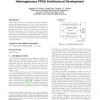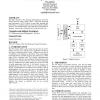FPGA
2009
ACM
14 years 8 months ago
2009
ACM
FPGA
2009
ACM
14 years 8 months ago
2009
ACM
Clock network power in field-programmable gate arrays (FPGAs) is considered and two complementary approaches for clock power reduction in the Xilinx R VirtexTM -5 FPGA are presen...
FPGA
2009
ACM
14 years 8 months ago
2009
ACM
Aggressive scaling increases the number of devices we can integrate per square millimeter but makes it increasingly difficult to guarantee that each device fabricated has the inte...
FPGA
2009
ACM
14 years 8 months ago
2009
ACM
Carbon nanotubes (CNTs), with their unique electronic properties, are promising materials for building nanoscale circuits. In this paper, we present a new CNT-based FPGA architect...
FPGA
2009
ACM
14 years 8 months ago
2009
ACM
In this paper we present SPR, a new architecture-adaptive mapping tool for use with Coarse-Grained Reconfigurable Architectures (CGRAs). It combines a VLIW style scheduler and FP...
FPGA
2009
ACM
14 years 8 months ago
2009
ACM
FPGA
2009
ACM
14 years 8 months ago
2009
ACM
This paper describes an analytical model that relates the architectural parameters of an FPGA to the average prerouting wirelength of an FPGA implementation. Both homogeneous and ...
FPGA
2009
ACM
14 years 8 months ago
2009
ACM
Via-programmable gate arrays (VPGAs) offer a middle ground between application specific integrated circuits and field programmable gate arrays in terms of flexibility, manufac...
FPGA
2009
ACM
14 years 8 months ago
2009
ACM
This paper describes a bus mastering implementation of the PCI Express protocol using a Xilinx FPGA. While the theoretical peak performance of PCI Express is quite high, attaining...
FPGA
2009
ACM
14 years 8 months ago
2009
ACM
PERG is a pattern matching engine designed for locating predefined byte string patterns (rules) from the ClamAV virus signature database in a data stream. This paper presents PERG...







